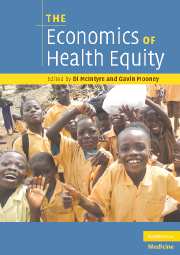Book contents
- Frontmatter
- Contents
- Contributors
- Biographies
- Acknowledgements
- Section 1 Introduction
- Section 2 Equity in general
- Section 3 Health service access
- Section 4 Equity and health systems
- Section 5 Lessons from individual countries
- 10 Equity in health financing, resource allocation and health service utilization in Brazil: past, present and future
- 11 Improving health-related information systems to monitor equity in health: lessons from Thailand
- Section 6 Future action
- Index
- References
10 - Equity in health financing, resource allocation and health service utilization in Brazil: past, present and future
Published online by Cambridge University Press: 22 August 2009
- Frontmatter
- Contents
- Contributors
- Biographies
- Acknowledgements
- Section 1 Introduction
- Section 2 Equity in general
- Section 3 Health service access
- Section 4 Equity and health systems
- Section 5 Lessons from individual countries
- 10 Equity in health financing, resource allocation and health service utilization in Brazil: past, present and future
- 11 Improving health-related information systems to monitor equity in health: lessons from Thailand
- Section 6 Future action
- Index
- References
Summary
Summary
This chapter analyzes equity in the Brazilian health system from three perspectives: in its financing; in the geographical distribution of financial resources; and in health services utilization. The first section deals with the burden of health service financing across income deciles, by type of expenditure. The second section presents a comparison of the distribution of expenditure as established by the Ministry of Health in 2002 with an estimation by the authors of resource allocation based on need. This is followed in the final section by a review of some studies on inequalities across different socio-economic groups in health care services utilization in Brazil.
Although there remain substantial social inequalities with respect to access to and utilization of health services in Brazil, the relevant data indicate improvements in access to health services and reductions in social inequalities between 1998 and 2003. There has also been an improvement in the equity of resource allocation from the central government to the states and municipalities. While the financing of public health services out of taxation is almost proportional, this represents a rather low percentage of the overall health spend. This results in large out-of-pocket expenditures, particularly for the poor, which is clearly regressive, and at the same time reduces the ability of the state to implement redistributive policies.
Introduction
The current model of the Brazilian health system was introduced under the new Constitution of 1988 which, inspired by the idea of a national health system, created the Sistema Único de Saúde – the SUS, the principles of which are universality, comprehensiveness and free access to health care.
- Type
- Chapter
- Information
- The Economics of Health Equity , pp. 199 - 221Publisher: Cambridge University PressPrint publication year: 2007



